Model portfolios as the backbone of modern financial advisory amid quantitative logic, regulatory constraints, and new operational challenges
The paradox of mass personalization
In today’s financial landscape, a seemingly irreconcilable paradox emerges: growing demand for personalized investment solutions versus the need for scalable operations and strategic consistency. Model portfolios represent the evolutionary synthesis of this tension, combining methodological standardization with application flexibility.
This approach originated after the 2008 financial crisis, which exposed how extreme, unstructured personalization amplified systemic risks. The regulatory response—culminating in MiFID II—imposed new standards for traceability, suitability, and conflict-of-interest governance, making structured frameworks essential.
Model portfolios embody the DNA of advanced advisory, acting as codified informational sequences that encode an organization’s investment philosophy, enabling coherent replication at scale. They bridge top-down strategic frameworks with bottom-up client needs.
The anatomy of model portfolios
A model portfolio is a formal and dynamic construct that reflects a specific investment philosophy and can be adapted or replicated across individual accounts. Its primary role is not just allocation, but to serve as a reference framework that defines what, why, when, and how much to invest.
Each component must have a verifiable strategic rationale. Model portfolios provide a dynamic benchmark for evaluating relative performance and strategy adherence, going beyond traditional static benchmarks thanks to their forward-looking and actionable design.
From a regulatory standpoint, suitability constraints are built-in, making model portfolios pre-screened investment recommendations. They are also aligned with target markets and help translate complex strategies into understandable terms for advisors, ensuring message consistency across the organization.
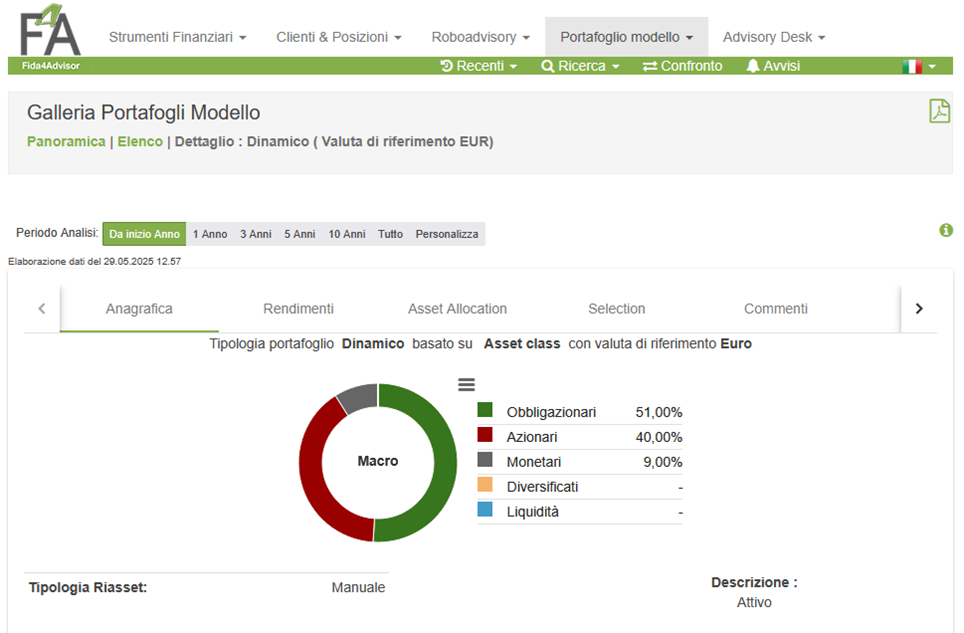
Source: FIDAworkstation
Strategic portfolios reflect long-term views based on structural drivers like growth, demographics, or inflation, with stable and diversified allocations. Tactical portfolios, instead, respond to short-term opportunities, adapting allocations based on market signals.
Hybrid architectures integrate both approaches, requiring a delicate balance between vision and flexibility.
Thematic portfolios, the most advanced form, are built around global trends such as aging, digitization, sustainability, and geopolitical shifts. ESG integration is not cosmetic—it becomes a core part of the selection process, balancing impact with performance.
Construction and optimization methodologies
The quantitative construction of model portfolios has undergone substantial evolution compared to traditional mean-variance optimization models. Modern methodologies integrate risk parity and risk budgeting, focusing on the balanced distribution of risk among portfolio components, equalizing each asset’s contribution according to predefined budgets.
Factor-based construction identifies and quantifies exposure to specific risk factors such as value, momentum, quality, size, and volatility, enabling more granular risk-return management. Regime-based modeling recognizes that markets shift through different regimes and adapts allocations accordingly, using Markov switching techniques or Bayesian approaches.
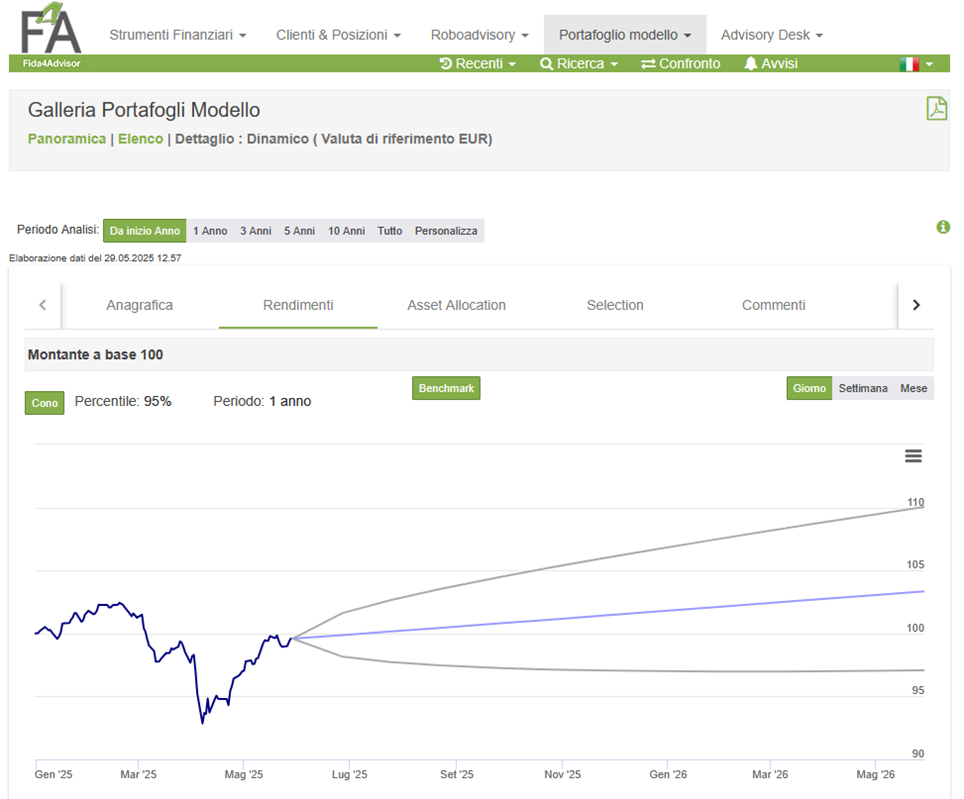
Source: FIDAworkstation
ESG integration has become an integral part of the optimization process, substantially modifying the investable universe and requiring new evaluation metrics that go beyond traditional financial parameters.
The hybrid decision-making process
The most advanced methodologies combine quantitative rigor and discretionary judgment through structured processes. Multidisciplinary Strategic Asset Allocation Committees define strategic market views, translating them into constraints and objectives for quantitative models. Decisions are formalized in terms of allocation ranges, expected returns, and forward-looking correlations.
The tactical allocation overlay temporarily modifies strategic weights based on tactical opportunities, governed by precise rules to avoid excessive discretionary drifts. Each model portfolio must undergo stress testing against plausible adverse scenarios, including both historical and hypothetical stress tests to assess resilience under extreme conditions.
Statistical validation requires backtesting on historical data and crucially out-of-sample validation to avoid overfitting and data mining bias, ensuring that models maintain effectiveness even in market conditions not foreseen during construction.
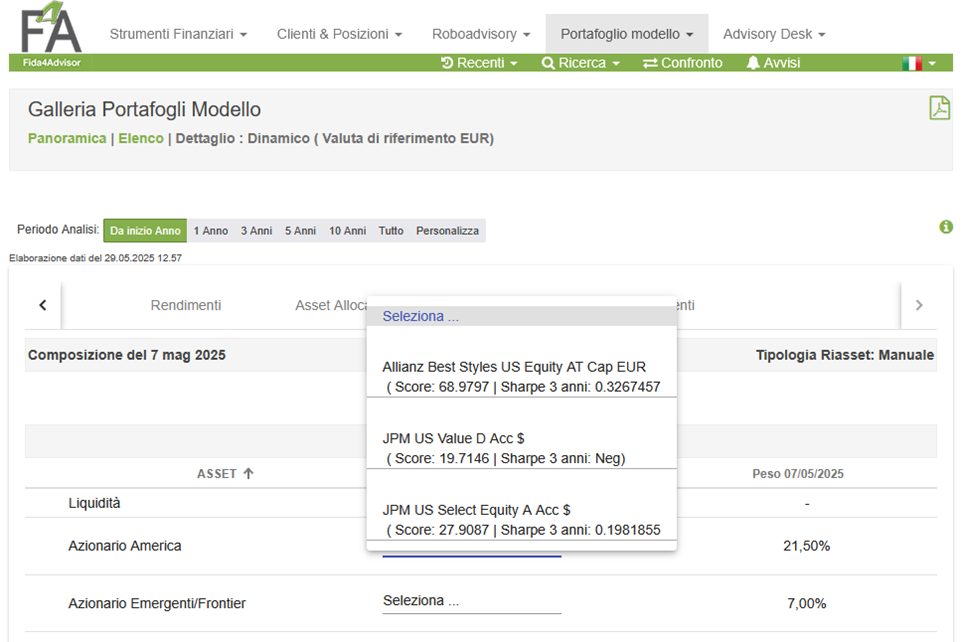
Source: FIDAworkstation
A critical aspect often overlooked is the practical implementability of model portfolios. The included assets must be sufficiently liquid to allow for scalable implementations and rapid divestments, particularly critical for segments like small caps, emerging markets, or corporate bond markets.
Optimal allocation must incorporate transaction costs, including bid-ask spreads, commissions, and market impact. The operational complexity of implementation must be considered, as portfolios with hundreds of small positions can become impractical.
The ecosystem of users
Retail banks and distribution networks
In the context of retail banks, model portfolios assume a strategic function that goes beyond operational simplification, representing the core of a complex ecosystem that balances industrial scalability, service personalization, and regulatory compliance. The fundamental paradox concerns the need to offer personalized services through standardized processes, providing a common matrix on which to build individual variations while maintaining predefined risk parameters and strategic coherence.
In networks with thousands of advisors, model portfolios serve as a vehicle for knowledge transfer, encapsulating the expertise of the central research office and making it accessible to advisors with varying levels of experience. MiFID II regulations require that each recommendation be consistent with the identified target market, and pre-validated model portfolios reduce compliance risk by providing recommendations already aligned with specific risk profiles.
Asset management companies
For asset management companies, model portfolios represent tools for competitive positioning and reputational risk management. They serve as laboratories for the development of new products, allowing for the testing of allocations before launching new funds and collecting feedback from the distribution network.
Competitive benchmarking uses model portfolios to compare the performance of their funds with alternatives built using competitors’ products, providing insights into relative value propositions. Model portfolios allow for stress tests and scenario analyses on broader universes than individual funds, identifying hidden correlations and systemic risks.
Family offices and private banking
In the ultra-high-net-worth segment, model portfolios take on different connotations, reflecting higher sophistication needs. Family offices typically manage complex portfolios that combine direct management, third-party funds, alternative investments, and direct investing, using model portfolios as a strategic framework to coordinate these different building blocks.
In family contexts, they facilitate strategic discussions by providing a common language and shared objectives, helping to separate strategic decisions from tactical ones that can be delegated to managers. They play a crucial role in succession planning, codifying the family’s investment philosophy in a way that is transferable to future generations.
Independent financial advisors
Independent advisors use model portfolios to industrialize investment management processes without losing service personalization, competing with large networks while maintaining low operational costs. Having stricter fiduciary responsibilities, they use model portfolios to provide robust documentation of investment choices, protecting themselves from potential disputes.
Operational challenges and critical issues
Versioning and historical tracking
One of the most underestimated issues concerns version control and the historical tracking of changes. Each change in allocation generates cascading implications that must be managed precisely. A formalized change management process is necessary, specifying the rationale for the change, the expected impact on risk-return metrics, implementation timing, and ex-post evaluation criteria.
When a model portfolio is modified, it becomes crucial to separate the performance attributable to the original strategy from that resulting from the changes, requiring sophisticated performance attribution techniques. Each change must be promptly communicated to the distribution network, with clear indications on how to implement the changes on existing portfolios.
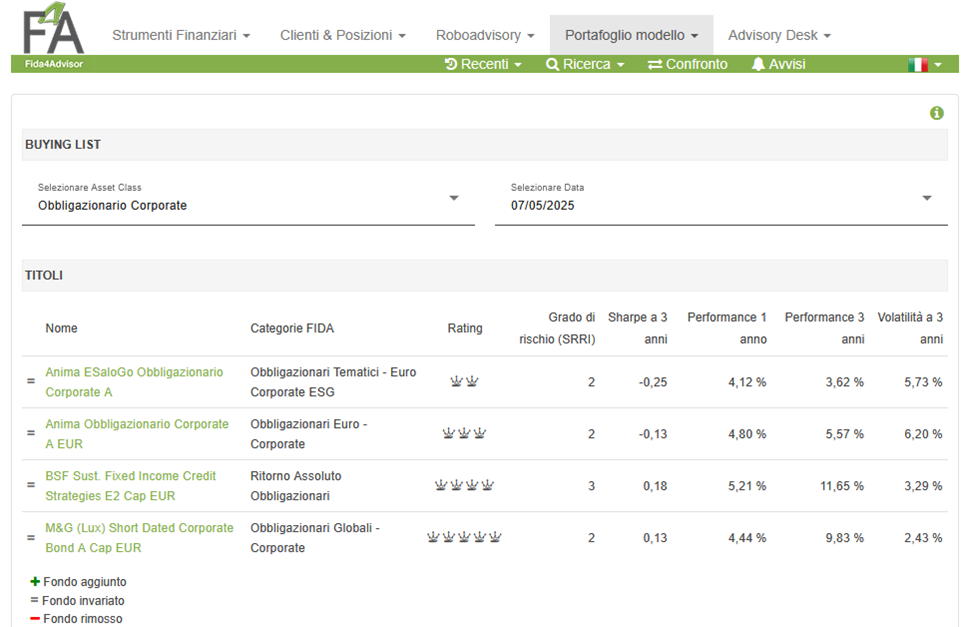
Source: FIDAworkstation
Compliance and target market validation
Regulatory compliance represents one of the most complex challenges, requiring a multidimensional approach that integrates legal, operational, and technological aspects. Each model portfolio must be associated with a clearly defined target market, specifying the type of client for whom it is appropriate, the required knowledge and experience, the minimum financial situation, and compatible investment objectives.
Model portfolios must facilitate the suitability assessment process through informational granularity that allows for automatic verification of compatibility between the client’s profile and the model’s characteristics. For organizations operating in multiple jurisdictions, regionalized variants of the same strategic model may be necessary to comply with different national regulatory frameworks.
Technological infrastructure and data management
Effective management requires sophisticated technological infrastructure that integrates various functionalities. Model portfolios rely on quality and consistent data, including data validation processes, handling of outliers, and management of missing data. Real-time update capability becomes a competitive advantage, requiring architectures that support low-latency data processing.
Integration with existing portfolio management, order management, risk management, and compliance systems is often complex and requires standardized APIs and robust data exchange protocols. The infrastructure must scale without performance degradation, both computationally and in terms of storage.
FIDAworkstation: the atelier of allocative architecture
In the landscape of modern financial advisory, technology represents the substrate on which operational effectiveness is founded. Financial organizations face converging challenges: scaling advisory processes while maintaining high-quality standards, ensuring real-time regulatory compliance, and providing transparency at every stage of the decision-making process.
FIDAworkstation, through its dedicated module, represents the evolution of traditional portfolio management systems, transforming model portfolios from theoretical constructs into living operational tools. The architecture reflects a deep understanding of organizational dynamics, recognizing that effectiveness depends on the ability to orchestrate interaction between different decision-making levels.
Functional architecture
The core of the approach lies in the distinction between admin and base users, reflecting the decision-making stratification of financial organizations. The admin user has access to strategic functionalities that allow for the creation and modification of model portfolios with extreme granularity, specifying not only asset allocation but also crucial metadata such as target market, risk profiles, reference benchmarks, and operational constraints.
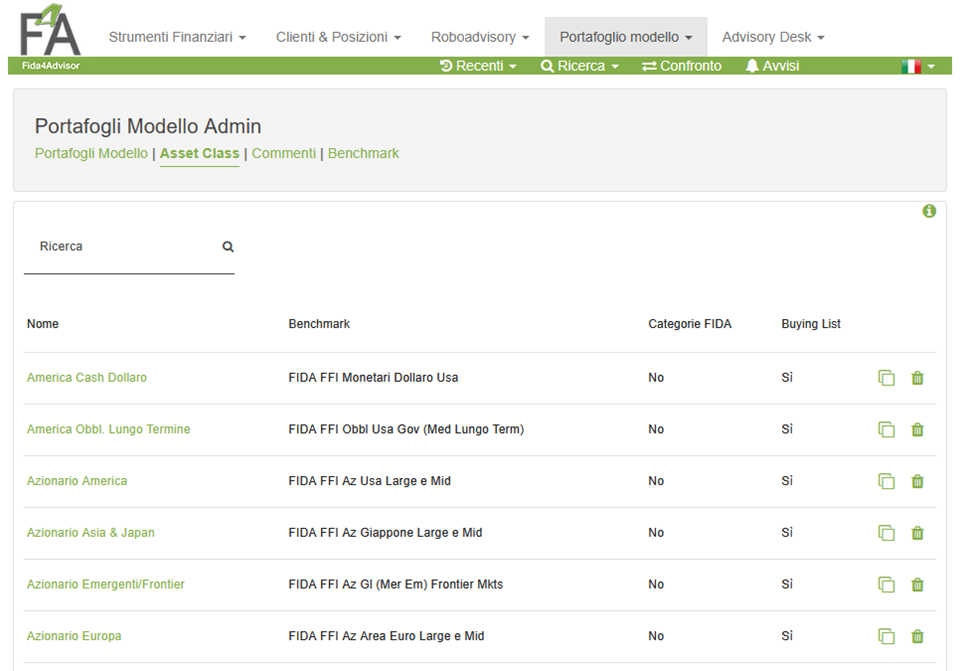
Source: FIDAworkstation
The publishing and distribution control process automatically includes compliance checks, consistency controls, and validations against defined target markets. Each change is tracked through a versioning system that maintains the complete history of allocation evolutions, ensuring complete audit trails and allowing for comparative analyses.
For base users, operational financial advisors access model portfolios through an intuitive “gallery” that presents each model with its salient features. The system allows for multidimensional comparisons between different model portfolios, facilitating the most appropriate selection for specific client needs, including quantitative and qualitative metrics.
Compliance integration
In a complex regulatory environment, Advisory Desk integrates compliance automation functionalities that transform regulatory obligations from operational constraints into competitive advantages. Automated suitability checks automatically compare each model portfolio with clients’ suitability profiles, identifying potential mismatches before they become compliance issues.
Target market validation continuously monitors model portfolios against the defined target markets, with automatic alerts when allocation changes could affect compatibility with specific client categories. Each action generates complete audit trails that document not only “what” was done, but also “why” and “by whom”.
A gallery of opportunities
For base users—the final recipients of model architectures created by master users—the interface provides an immediate yet comprehensive overview of the available investment universe. Model portfolios are displayed with graphical summaries of their historical performance, target market, and underlying strategy, offering an intuitive but informative first layer of analysis.

Source: FIDAworkstation
Thanks to an advanced filtering system, users can isolate solutions that align with their personal suitability parameters: from level of knowledge and experience to risk tolerance, loss-bearing capacity, and investment horizon. The filters also include more sophisticated aspects such as compatibility with ESG criteria, base currency, and portfolio structure type (absolute return, static, dynamic, target date). Even the model’s intrinsic nature—asset class, meta-portfolio, or securities selection—can be selected, ensuring a vertically integrated experience aligned with regulatory and advisory constraints.
The architecture of the financial future
I
Model portfolios are much more than an operational innovation: they embody a new paradigm in financial advisory that reconciles the need for industrial scalability with that of genuine personalization. In an age of increasing regulatory complexity and technological sophistication, they serve as a bridge between institutional investment strategy and its practical implementation within the advisor-client relationship.
The evolution toward integrated technological systems is not simply a technological upgrade but a conceptual transformation that redefines the role of the financial advisor. From being a distributor of financial products, the advisor evolves into an architect of personalized solutions built on solid, traceable strategic foundations.
This transformation addresses converging demands: clients seek greater transparency and clarity, regulators require more traceability and appropriateness, and financial organizations need increased operational efficiency and risk control. Model portfolios, supported by advanced technology platforms, offer a systemic solution—transforming complexity into clarity, arbitrariness into coherence, and inefficiency into measurable added value.
The future evolution will be driven by three main trends:
-
The growing integration of artificial intelligence for dynamic optimization
-
The systematic incorporation of ESG and impact criteria
-
The democratization of access to sophisticated portfolio management capabilities
Organizations that master the art of building, managing, and distributing effective model portfolios will not only gain measurable competitive advantages but also raise the qualitative standards of the entire financial industry.
Investing in dedicated technologies is not an operational cost, but a strategic investment in the architecture of the financial future—a future where technology amplifies human intelligence rather than replaces it, where standardization enables rather than restricts personalization, and where compliance becomes an enabler of innovation rather than a constraint on growth.
Monica F. Zerbinati

Richiedi la prova gratuita a welcometeam@fidaonline.com